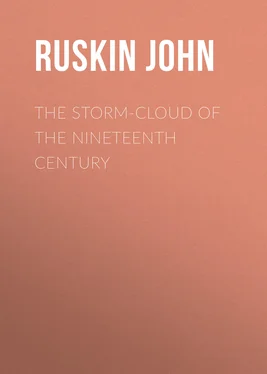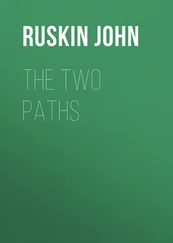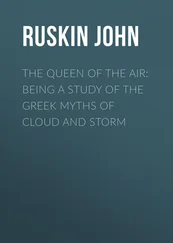John Ruskin - The Storm-Cloud of the Nineteenth Century
Здесь есть возможность читать онлайн «John Ruskin - The Storm-Cloud of the Nineteenth Century» — ознакомительный отрывок электронной книги совершенно бесплатно, а после прочтения отрывка купить полную версию. В некоторых случаях можно слушать аудио, скачать через торрент в формате fb2 и присутствует краткое содержание. Жанр: foreign_prose, literature_19, foreign_antique, на английском языке. Описание произведения, (предисловие) а так же отзывы посетителей доступны на портале библиотеки ЛибКат.
- Название:The Storm-Cloud of the Nineteenth Century
- Автор:
- Жанр:
- Год:неизвестен
- ISBN:нет данных
- Рейтинг книги:3 / 5. Голосов: 1
-
Избранное:Добавить в избранное
- Отзывы:
-
Ваша оценка:
- 60
- 1
- 2
- 3
- 4
- 5
The Storm-Cloud of the Nineteenth Century: краткое содержание, описание и аннотация
Предлагаем к чтению аннотацию, описание, краткое содержание или предисловие (зависит от того, что написал сам автор книги «The Storm-Cloud of the Nineteenth Century»). Если вы не нашли необходимую информацию о книге — напишите в комментариях, мы постараемся отыскать её.
The Storm-Cloud of the Nineteenth Century — читать онлайн ознакомительный отрывок
Ниже представлен текст книги, разбитый по страницам. Система сохранения места последней прочитанной страницы, позволяет с удобством читать онлайн бесплатно книгу «The Storm-Cloud of the Nineteenth Century», без необходимости каждый раз заново искать на чём Вы остановились. Поставьте закладку, и сможете в любой момент перейти на страницу, на которой закончили чтение.
Интервал:
Закладка:
The main cause of this change being, that the prismatic cloud itself is always in rapid, and generally in fluctuating motion. "A light veil of clouds had drawn itself," says Professor Tyndall, in describing his solitary ascent of Monte Rosa, "between me and the sun, and this was flooded with the most brilliant dyes. Orange, red, green, blue—all the hues produced by diffraction—were exhibited in the utmost splendor.
"Three times during my ascent (the short ascent of the last peak) similar veils drew themselves across the sun, and at each passage the splendid phenomena were renewed. There seemed a tendency to form circular zones of color round the sun; but the clouds were not sufficiently uniform to permit of this, and they were consequently broken into spaces, each steeped with the color due to the condition of the cloud at the place."
Three times, you observe, the veil passed, and three times another came, or the first faded and another formed; and so it is always, as far as I have registered prismatic cloud: and the most beautiful colors I ever saw were on those that flew fastest.
This second diagram is enlarged admirably by Mr. Arthur Severn from my sketch of the sky in the afternoon of the 6th of August, 1880, at Brantwood, two hours before sunset. You are looking west by north, straight towards the sun, and nearly straight towards the wind. From the west the wind blows fiercely towards you out of the blue sky. Under the blue space is a flattened dome of earth-cloud clinging to, and altogether masking the form of, the mountain, known as the Old Man of Coniston.
The top of that dome of cloud is two thousand eight hundred feet above the sea, the mountain two thousand six hundred, the cloud lying two hundred feet deep on it. Behind it, westward and seaward, all's clear; but when the wind out of that blue clearness comes over the ridge of the earth-cloud, at that moment and that line, its own moisture congeals into these white—I believe, ice -clouds; threads, and meshes, and tresses, and tapestries, flying, failing, melting, reappearing; spinning and unspinning themselves, coiling and uncoiling, winding and unwinding, faster than eye or thought can follow: and through all their dazzling maze of frosty filaments shines a painted window in palpitation; its pulses of color interwoven in motion, intermittent in fire,—emerald and ruby and pale purple and violet melting into a blue that is not of the sky, but of the sunbeam;—purer than the crystal, softer than the rainbow, and brighter than the snow.
But you must please here observe that while my first diagram did with some adequateness represent to you the color facts there spoken of, the present diagram can only explain , not reproduce them. The bright reflected colors of clouds can be represented in painting, because they are relieved against darker colors, or, in many cases, are dark colors, the vermilion and ruby clouds being often much darker than the green or blue sky beyond them. But in the case of the phenomena now under your attention, the colors are all brighter than pure white ,—the entire body of the cloud in which they show themselves being white by transmitted light, so that I can only show you what the colors are, and where they are,—but leaving them dark on the white ground. Only artificial, and very high illumination would give the real effect of them,—painting cannot.
Enough, however, is here done to fix in your minds the distinction between those two species of cloud,—one, either stationary, 16or slow in motion, reflecting unresolved light; the other, fast-flying, and transmitting resolved light. What difference is there in the nature of the atoms, between those two kinds of clouds? I leave the question with you for to-day, merely hinting to you my suspicion that the prismatic cloud is of finely-comminuted water, or ice, 17instead of aqueous vapor; but the only clue I have to this idea is in the purity of the rainbow formed in frost mist, lying close to water surfaces. Such mist, however, only becomes prismatic as common rain does, when the sun is behind the spectator, while prismatic clouds are, on the contrary, always between the spectator and the sun.
The main reason, however, why I can tell you nothing yet about these colors of diffraction or interference, is that, whenever I try to find anything firm for you to depend on, I am stopped by the quite frightful inaccuracy of the scientific people's terms, which is the consequence of their always trying to write mixed Latin and English, so losing the grace of the one and the sense of the other. And, in this point of the diffraction of light I am stopped dead by their confusion of idea also, in using the words undulation and vibration as synonyms. "When," says Professor Tyndall, "you are told that the atoms of the sun vibrate at different rates, and produce waves of different sizes,—your experience of water-waves will enable you to form a tolerably clear notion of what is meant."
'Tolerably clear'!—your toleration must be considerable, then. Do you suppose a water-wave is like a harp-string? Vibration is the movement of a body in a state of tension,—undulation, that of a body absolutely lax. In vibration, not an atom of the body changes its place in relation to another,—in undulation, not an atom of the body remains in the same place with regard to another. In vibration, every particle of the body ignores gravitation, or defies it,—in undulation, every particle of the body is slavishly submitted to it. In undulation, not one wave is like another; in vibration, every pulse is alike. And of undulation itself, there are all manner of visible conditions, which are not true conditions. A flag ripples in the wind, but it does not undulate as the sea does,—for in the sea, the water is taken from the trough to put on to the ridge, but in the flag, though the motion is progressive, the bits of bunting keep their place. You see a field of corn undulating as if it was water,—it is different from the flag, for the ears of corn bow out of their places and return to them,—and yet, it is no more like the undulation of the sea, than the shaking of an aspen leaf in a storm, or the lowering of the lances in a battle.
And the best of the jest is, that after mixing up these two notions in their heads inextricably, the scientific people apply both when neither will fit; and when all undulation known to us presumes weight, and all vibration, impact,—the undulating theory of light is proposed to you concerning a medium which you can neither weigh nor touch!
All communicable
Конец ознакомительного фрагмента.
Текст предоставлен ООО «ЛитРес».
Прочитайте эту книгу целиком, купив полную легальную версию на ЛитРес.
Безопасно оплатить книгу можно банковской картой Visa, MasterCard, Maestro, со счета мобильного телефона, с платежного терминала, в салоне МТС или Связной, через PayPal, WebMoney, Яндекс.Деньги, QIWI Кошелек, бонусными картами или другим удобным Вам способом.
1
The vapor over the pool of Anger in the 'Inferno,' the clogging stench which rises from Caina, and the fog of the circle of Anger in the 'Purgatorio' resemble, indeed, the cloud of the Plague-wind very closely,—but are conceived only as supernatural. The reader will no doubt observe, throughout the following lecture, my own habit of speaking of beautiful things as 'natural,' and of ugly ones as 'unnatural.' In the conception of recent philosophy, the world is one Kosmos in which diphtheria is held to be as natural as song, and cholera as digestion. To my own mind, and the more distinctly the more I see, know, and feel, the Earth, as prepared for the abode of man, appears distinctly ruled by agencies of health and disease, of which the first may be aided by his industry, prudence, and piety; while the destroying laws are allowed to prevail against him, in the degree in which he allows himself in idleness, folly, and vice. Had the point been distinctly indicated where the degrees of adversity necessary for his discipline pass into those intended for his punishment, the world would have been put under a manifest theocracy; but the declaration of the principle is at least distinct enough to have convinced all sensitive and earnest persons, from the beginning of speculation in the eyes and mind of Man: and it has been put in my power by one of the singular chances which have always helped me in my work when it was in the right direction, to present to the University of Oxford the most distinct expression of this first principle of mediæval Theology which, so far as I know, exists in fifteenth-century art. It is one of the drawings of the Florentine book which I bought for a thousand pounds, against the British Museum, some ten or twelve years since; being a compendium of classic and mediæval religious symbolism. In the two pages of it, forming one picture, given to Oxford, the delivery of the Law on Sinai is represented on the left hand, ( contrary to the Scriptural narrative , but in deeper expression of the benediction of the Sacred Law to all nations,) as in the midst of bright and calm light, the figure of the Deity being supported by luminous and level clouds, and attended by happy angels: while opposite, on the right hand, the worship of the Golden Calf is symbolized by a single decorated pillar, with the calf on its summit, surrounded by the clouds and darkness of a furious storm, issuing from the mouths of fiends;—uprooting the trees, and throwing down the rocks, above the broken tables of the Law, of which the fragments lie in the foreground.
Читать дальшеИнтервал:
Закладка:
Похожие книги на «The Storm-Cloud of the Nineteenth Century»
Представляем Вашему вниманию похожие книги на «The Storm-Cloud of the Nineteenth Century» списком для выбора. Мы отобрали схожую по названию и смыслу литературу в надежде предоставить читателям больше вариантов отыскать новые, интересные, ещё непрочитанные произведения.
Обсуждение, отзывы о книге «The Storm-Cloud of the Nineteenth Century» и просто собственные мнения читателей. Оставьте ваши комментарии, напишите, что Вы думаете о произведении, его смысле или главных героях. Укажите что конкретно понравилось, а что нет, и почему Вы так считаете.












